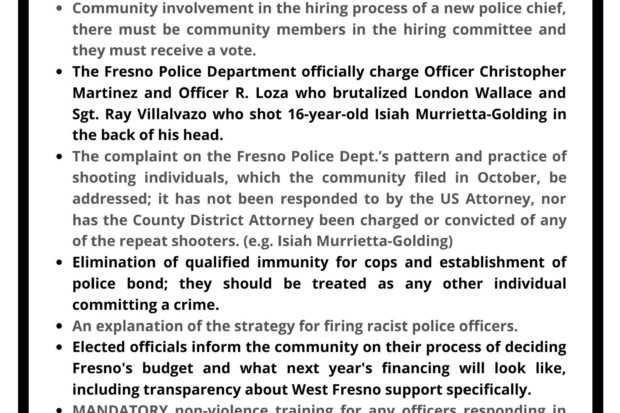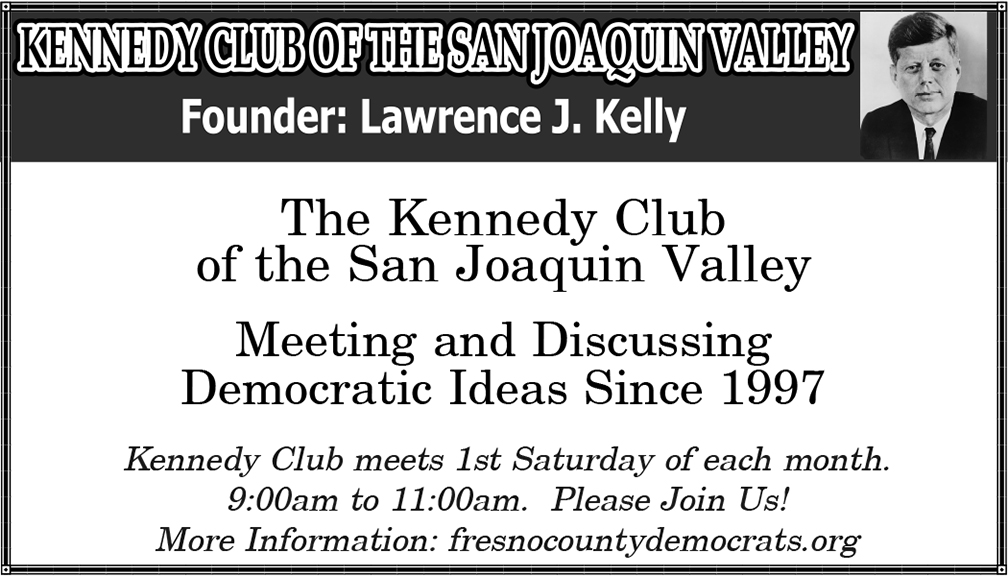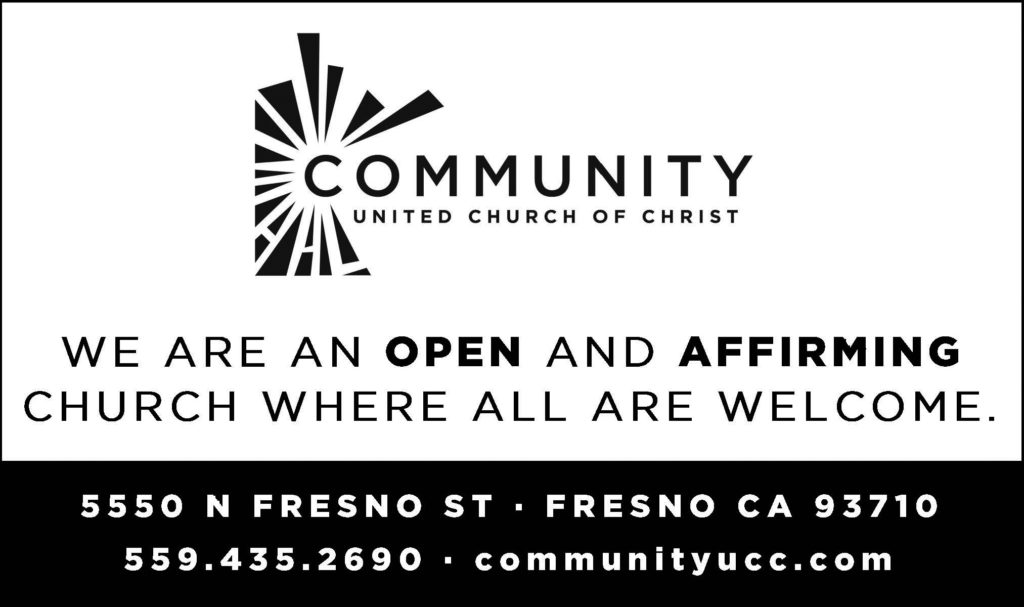
By James Mendez
On June 25, the Fresno City Council voted 5-1 to fund Advance Peace in its 2020–21 budget. Advanced Peace brings a community-based program to Fresno and will work to decrease homicides. The City Council allocated at least $125,000 yearly, but no more than $300,000, with yearly renewals for three years based on achieving certain metrics.
These are times of less resources due to the economic impact of the pandemic. Even so, this is a small amount of the almost $1.2 billion budget. The city budget includes $346 million for the General Fund, which includes $175 million for police. If the program is able to prevent just one death it will be beneficial given that each death by gun violence costs Fresno County $2.4 million.1
Utilizing programs such as Advance Peace are part of ongoing discussions in Fresno and nationwide to reform police. The hope is that reform of America’s police will result in less racist policing practices and decrease police violence. In particular, reform needs to decrease violence directed toward Black people.
There is also talk about “defunding police.” The expectation is there would be a better governmental response to nonviolent social problems such as acute mental health crisis and homelessness. Taking away those responsibilities from the police might also decrease the violence perpetrated by police.2,3
Since the George Floyd murder on May 25, the historical role of police in oppressing people of color is being evaluated again. Racial discrimination, racial profiling and brutality by police are not recent phenomena.
There has been racial discrimination in America since the late 1400s when captured Africans were forcibly brought to the Americas as slaves. By 1526, African slaves had been brought to several areas that would later become part of the United States (Florida and the Carolinas).
The African slave trade had been present in the Americas (Mexico, Brazil, the Caribbean) for more than 100 years when in late August 1619, a slave ship named the White Lion set anchor in the James River at Point Comfort, Va. The ship was an English privateer ship carrying “20 and odd” Africans to Virginia. Although they were exchanged for food as indentured servants, this was the beginning of the American institution of slavery.4
Since the beginning of British colonization of America, the ruling class has subjected native people, people of color and immigrants to oppression using excessive policing and violence. Initially, the ruling class used sheriffs, constables and night watchmen for law enforcement.
Starting in the 1830s, publicly funded police departments were formed in northern cities to perform law enforcement. Publicly funded police departments were formed in the South after the Civil War.

Background of Police Development North versus South
In the North, prior to the 1830s, businesses paid private security officers to protect their property and suppress workers complaining about working conditions. Publicly funded police departments were formed with the encouragement of business civic leaders to replace the private security officers that businesses were paying to protect their property.
By having publicly funded police departments, businesses were able to use public employees (the police) to serve the private economic interests of business. Business was also able to take advantage of the legal use of force by police.
Police were used against workers and immigrants who were protesting and organizing against poor living and poor working conditions. Business use of free publicly funded police was both cost-effective for manufacturing concerns, and politically useful, because it conflated the issue of workers’ rights with the issue of crime.
The development of police departments was different in the South. The southern British American colonies relied almost exclusively on slave labor for their agricultural work. The increasing number of slaves and the relatively small number of Whites in the South caused the plantation owners to live in constant fear of slave rebellions disrupting their social, political and economic status.
“The ruling class used publicly funded, armed, militarized police to protect their property, guard their wealth and maintain their economic and political control over native people, African Americans and immigrants.”
White plantation owners used brutal violence to maintain slavery, discourage runaways, prevent insurrections and control the African slaves. In 1663, the first recorded British American slave rebellion occurred in Gloucester County, Virginia. In response to the rebellion, the first Slave Codes were enacted in 1664 in the colonies of Maryland and Virginia.5
The Slave Codes spread throughout the colonies. The Slave Codes defined a slave as a piece of property without any rights. The Slave Codes allowed masters of slaves to inflict punishment for any behavior identified as unacceptable.
To maintain order and enforce the Slave Codes, the plantation owners instituted slave patrols in 1704. The first one was in the Carolina colony. Eventually, all the colonies had slave patrols. Starting in the 1700s, slave patrols functioned as state militia in the Southern colonies. The slave patrols served to preserve White control and protect the slave owners against insurrection.
Slave patrols initially consisted of groups of White male volunteers to enforce the Slave Code laws. Over time, all the White adult men were legally compelled by local authorities to serve on the slave patrols. Participating in slave patrols was the civic duty of all White men until the 1830s.
The slave patrols helped maintain slavery through the following actions:
- Slave patrols used their broad authority to chase down, apprehend and return runaway slaves to their owners. Members of slave patrols could forcefully enter anyone’s home, regardless of their race or ethnicity, based on suspicions that they were sheltering people who had escaped bondage.
- Slave patrols would serve summary justice, outside of the law, to brutally punish slaves with beatings and whippings if the slaves were thought to have violated any plantation rules such as violating curfew, traveling without a permission pass or assembling without permission. In so doing, slave patrols would provide a form of organized terror in an effort to deter future slave revolts, rebellions and insurrections.
- When slave patrols returned captured slaves to their masters, there was also the threat of being sold for disobedience and thus separated from their families.
Starting with Pennsylvania in 1780, slavery and slave patrols were outlawed by eight of the then 17 states over a period of 20 years. By the late 1790s, slave patrols were still active in all nine slave states in the country.
“With a self-sustaining population of over four million slaves in the South, some Southern congressmen joined with the North in voting to abolish the African slave trade, an act that became effective January 1, 1808.” While the African slave trade was abolished in the United States in 1808, slavery and the buying and selling of slaves, along with slave patrols, continued within the U.S. boundaries.6

Slave Patrols Transformed to Police Departments
For 150 years, from 1704 to 1865, slave patrols were a legally sanctioned law enforcement system in America. Slave patrols were used for the express purpose of controlling the slave population and protecting the interests of slave owners.
With the end of the Civil War came the end of slavery. Ratified on Dec. 6, 1865, the 13th Amendment abolished slavery in the United States and thereby ended the slave patrols. Even though slave patrols ended after the Civil War, racism did not end.
The commitment of White southern landowners to maintain their control of the African American labor force, their supremacy and their plantation agriculture system continued after the Civil War. From 1865 to 1868, former slave state governments issued Black Code laws to continue their control of a similar economic and political system that had existed during the previous 200 years of slavery.
Under the Black Codes, Southern Whites introduced vagrancy and labor contract laws at the state, county and municipal levels. Those laws required African Americans to have written evidence of employment or be arrested for vagrancy. If they were arrested and were unable to pay the fines, the former slaves would have to perform plantation work for free.
There were other laws that African Americans could only work as a farmer or a servant. The laws specified how, when and where African Americans could work and how much they would be paid. They also restricted African American voting rights, dictated how and where African Americans could travel and limited where they could live.7
The Black Codes ended when the U.S. Congress ratified the 14th Amendment in 1868, which granted citizenship to all persons born or naturalized in the United States—including former slaves—and guaranteed all citizens “equal protection of the laws.” The 14th Amendment made the Black Codes illegal by giving formerly enslaved blacks equal protection of laws through the Constitution.
Starting in 1868, the former slave states started to institute “Jim Crow Laws” (separate but equal laws) to legally enforce and maintain segregation with separate public spaces (like schools, hospitals, transportation, libraries, water fountains and restaurants) for Blacks and Whites. The Jim Crow laws remained in place until the passage of the Civil Rights Act of 1964.
Jim Crow laws subjugated African Americans and denied them their civil rights. Police were charged with enforcing the Jim Crow laws. Blacks who broke those laws, or violated the unwritten social norms, were subject to arrest by the police and often subjected to police brutality.
After the Civil War, in the South’s slave patrols were transformed into all-White police departments and state militia forces. Police departments often were made up of Confederate veterans of the Civil War and the very same men who had been members of slave patrols before the Civil War.
Southern police departments enforced the Black Codes and the subsequent Jim Crow laws. Southern police departments often continued the other functions of the slave patrols in the same violent fashion.

Even though slavery, the Slave Codes and the Black Codes were eliminated, the police legally oppressed African Americans through the enforcement of the Jim Crow laws. By enforcing Jim Crow laws, police performed systematic surveillance of African Americans. Just as slave patrols had done in the 1800, the police enforced curfews and “sundown laws.”
Police departments generally excluded African Americans from becoming police officers. During Reconstruction and the Jim Crow period, the few African-American police officers were usually relegated to token positions.
Regardless of location in the United States, since the mid-1800s the ruling class of cities and towns across America developed similar police departments.
The ruling class used publicly funded, armed, militarized police to protect their property, guard their wealth and maintain their economic and political control over native people, African Americans and immigrants. One of the reasons given for the systemic racism in current police departments is that many police departments, which are publicly funded to serve all the people, were formed using racist slave patrols as models for the department.
People are now asking how such a police system can fairly and safely monitor, oversee and protect African Americans.
Generally speaking, like the slave patrols of the South, police nationwide have used racism and brutality to enforce the laws created by the dominant political groups. Those laws were formed to maintain control and order over native people, African Americans, immigrants, union organizers and others who might disrupt the social, economic or political order.
For these reasons, many people are calling for significant reform of and to “defund” police departments.
References:
- https://www.fresno.gov/finance/wp-content/uploads/sites/11/2020/06/FY-2020-Adopted-Police-Department-Budget.pdf
- https://www.politico.com/news/magazine/2020/06/12/abolish-defund-police-explainer-316185; June 12, 2020; Politico article about defunding the police.
- https://www.brookings.edu/blog/fixgov/2020/06/19/what-does-defund-the-police-mean-and-does-it-have-merit/
- https://plsonline.eku.edu/insidelook/history-policing-united-states-part-1; June 25, 2013; six-part article on the history of policing in the United States from colonial times to the present by Dr. Gary Potter of Eastern Kentucky University (EKU). Dr. Gary Potter is a professor of online and on-campus courses for the EKU School of Justice Studies.
- https://www.history.com/news/american-slavery-before-jamestown-1619. History of slavery in America before 1619.
- https://www.google.com/amp/s/www.history.com/.amp/this-day-in-history/congress-abolishes-the-african-slave-trade
- https://www.history.com/topics/black-history/black-codes; history of the Black Codes.
*****
James “Jim” Mendez, born in Los Angeles, came to Fresno 1977 to do a residency in internal medicine and stayed. He retired as a physician, but continues to work as a political activist and is a member of CVPPAC. He is known as “grandpa Jim” to his grandchildren. He is a supporter of public education having been a recipient from kindergarten through medical school. He and his wife are thankful for this time of their lives to spend time with their daughters and grandchildren. Contact him at jim_mendez@icloud.com.
